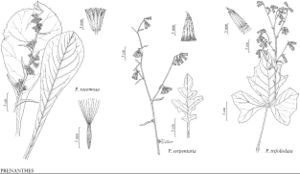Prenanthes racemosa
Fl. Bor.-Amer. 2: 84. 1803.
Plants 30–175 cm; taproots fusiform, tuberous. Stems erect, green or light purple, simple, (stout), glabrous and glaucous proximally, setose or hispid distally. Leaves: proximal usually present at flowering; petioles broadly winged, (1–15 cm); blades broadly oblanceolate to spatulate, 4–25 × 1–8 cm, coriaceous, bases attenuate, clasping, margins entire or weakly denticulate, apices obtuse or rounded, faces glabrous; mid cauline sessile, clasping; distal sessile and reduced. Heads (ascending) in (elongate) narrowly racemiform or paniculiform arrays. Involucres campanulate, 11–12 × 4–7 mm. Calyculi of 8, dark green to purple, narrowly triangular-subulate bractlets 2–4 mm, coarsely setose. Phyllaries 7–14, green to purple, lanceolate to linear, 10–12 mm, margins scarious, sparsely to densely setose. Florets 9–29; corollas usually pinkish, sometimes white or lavender, 7–13 mm. Cypselae golden brown, sub-cylindric, subterete, 5–6 mm, indistinctly 8–12-ribbed; pappi pale yellow, 6–7 mm. 2n = 16.
Phenology: Flowering Aug–Sep.
Habitat: Sandy alluvial soils of stream banks, wet meadows, tall-grass prairies, fens, marshy flats, bogs (mainly calcicolous, at least in north)
Elevation: 0–2800 m
Distribution

Alta., B.C., Man., N.B., Nfld. and Labr. (Nfld.), N.S., Ont., Que., Sask., Colo., Ill., Ind., Iowa, Ky., Maine, Mich., Minn., Mo., Mont., Nebr., N.J., N.Y., N.Dak., Ohio, Pa., S.Dak., Vt., Wash., Wis., Wyo.
Discussion
Prenanthes racemosa is recognized by its erect, stout, simple habit, glaucous stems, spatulate proximal leaves with broadly winged petioles and rounded to obtuse apices, heads borne in narrow racemiform arrays, purple and hairy phyllaries, and usually pinkish corollas. It is most similar to P. aspera, which differs in its generally smaller stature, more hirsute stems, leaves that are hispid abaxially, proximal leaves usually withered by flowering, and creamy white or yellow corollas. Hybrids between P. racemosa and P. trifoliolata, known as P. ×mainensis, occur in the northeastern United States and southeastern Canada (see discussion under P. trifoliolata).
Selected References
None.
